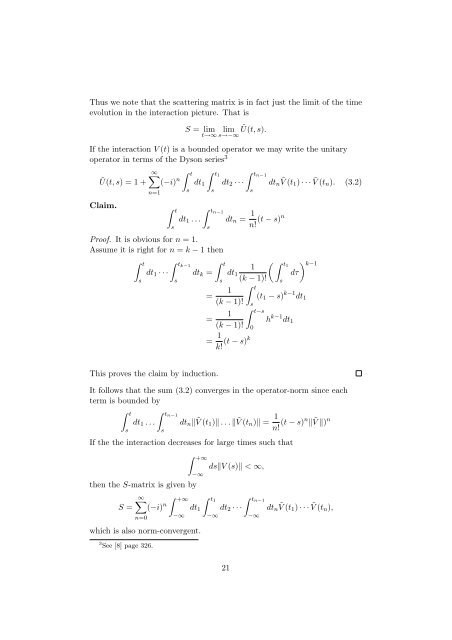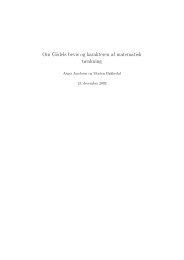Master Dissertation
Master Dissertation
Master Dissertation
Create successful ePaper yourself
Turn your PDF publications into a flip-book with our unique Google optimized e-Paper software.
Thus we note that the scattering matrix is in fact just the limit of the time<br />
evolution in the interaction picture. That is<br />
S = lim lim Ũ(t, s).<br />
t→∞ s→−∞<br />
If the interaction V (t) is a bounded operator we may write the unitary<br />
operator in terms of the Dyson series 3<br />
Ũ(t, s) = 1 +<br />
∞<br />
(−i) n<br />
n=1<br />
Claim. t<br />
s<br />
s<br />
s<br />
t<br />
s<br />
dt1<br />
t1<br />
s<br />
tn−1<br />
dt2 · · · dtn<br />
s<br />
˜ V (t1) · · · ˜ V (tn). (3.2)<br />
tn−1<br />
dt1 . . . dtn =<br />
s<br />
1<br />
(t − s)n<br />
n!<br />
Proof. It is obvious for n = 1.<br />
Assume it is right for n = k − 1 then<br />
t tk−1<br />
t<br />
t1 1<br />
dt1 · · · dtk = dt1<br />
(k − 1)!<br />
=<br />
This proves the claim by induction.<br />
s<br />
1<br />
(k − 1)!<br />
t<br />
1<br />
=<br />
(k − 1)!<br />
= 1<br />
(t − s)k<br />
k!<br />
s<br />
t−s<br />
0<br />
s<br />
k−1 dτ<br />
(t1 − s) k−1 dt1<br />
h k−1 dt1<br />
It follows that the sum (3.2) converges in the operator-norm since each<br />
term is bounded by<br />
t<br />
s<br />
dt1 . . .<br />
tn−1<br />
s<br />
dtn ˜ V (t1) . . . ˜ V (tn) = 1<br />
n! (t − s)n ˜ V ) n<br />
If the the interaction decreases for large times such that<br />
then the S-matrix is given by<br />
S =<br />
∞<br />
(−i) n<br />
n=0<br />
+∞<br />
−∞<br />
+∞<br />
−∞<br />
dt1<br />
which is also norm-convergent.<br />
3 See [8] page 326.<br />
t1<br />
dsV (s) < ∞,<br />
dt2 · · ·<br />
−∞<br />
21<br />
tn−1<br />
−∞<br />
dtn ˜ V (t1) · · · ˜ V (tn),



